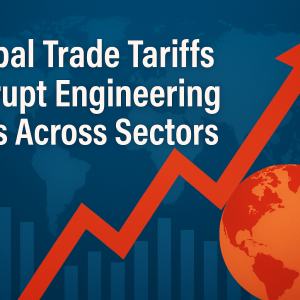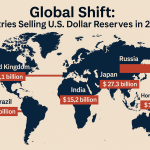Manufacturing, Automotive, Electronics, and Renewable Energy Face Headwinds as Nations Lock Horns
The latest wave of trade tariffs imposed by major global economies is triggering significant turbulence across engineering sectors worldwide. With protectionist policies on the rise—from the U.S. to the European Union and China—engineers are confronting supply chain shocks, shifting job markets, and an urgent need to adapt.
Manufacturing: From Reshoring Hopes to Job Loss Reality
Despite intentions to revitalize local industries, new tariffs are weighing heavily on global manufacturing. In the U.S., a recent increase in broad import tariffs has led to job cuts, particularly in steel-using sectors like appliances and heavy equipment. Factory activity dipped in Q1 2025 as companies struggled with rising costs and supply delays.
Germany’s export-heavy industrial sector is also reeling. After a short-lived spike in U.S. orders ahead of tariff deadlines, production levels fell, and engineering firms signaled a downturn in hiring expectations.
While a few sectors like domestic metals have seen minor job upticks, these are offset by larger employment declines across supply chain-dependent industries.
Automotive: Job Cuts, Higher Prices, and Frozen Investments
Nowhere is the tariff backlash more visible than in the automotive industry. The United States’ 25% import tariff on foreign-made vehicles has caused widespread disruption. Stellantis laid off nearly 900 workers across the U.S., Canada, and Mexico, attributing the cuts to “avoidable” policy shocks.
Industry analysts warn of an average 15% hike in vehicle prices—threatening sales and further employment. The European Union’s retaliatory 45% tariffs on Chinese EVs have heightened tensions, and Germany’s auto exports to the U.S. are taking a hit.
Carmakers are caught between higher costs, declining sales, and the expensive challenge of reshoring supply chains—pushing many to freeze hiring and delay expansions.
Electronics: Global Reallocation of Jobs
Trade restrictions on electronics, especially between the U.S., China, and Vietnam, are reshaping global employment in this tech-driven sector.
Companies like Apple and Samsung are accelerating production shifts to India under the “China+1” strategy. This could create a boom in engineering jobs in India and Mexico, while manufacturing hubs in China face factory slowdowns and layoffs.
Simultaneously, U.S. investments in domestic chip manufacturing and battery production offer hope for onshore job creation—but such projects may take years to offset current declines.
Civil Infrastructure: Cost Surges Stall Projects
Tariffs on construction inputs—steel, aluminum, and machinery—are raising the cost of civil infrastructure projects globally. In the U.S., material prices have climbed over 40% since pre-pandemic levels, with contractors delaying or canceling new builds due to unpredictable budgets.
Industry leaders warn of a potential freeze in public and private infrastructure spending, threatening future job creation for civil engineers, planners, and project managers.
Renewable Energy: A Sector at Crossroads
The renewable sector faces both opportunities and obstacles. U.S. solar panel production is rising, but tariffs on imported components may hinder the pace of deployment. Analysts warn of a repeat of 2018–2021, when import taxes led to the loss of over 60,000 solar jobs due to project cancellations.
While some countries like India stand to benefit from shifting supply chains, developers across the U.S. and EU are expressing concern over cost inflation and delayed projects.
In contrast, China’s clean-tech exporters are pivoting to new markets in South Asia and South America—possibly triggering green job creation elsewhere.
The Global Engineering Workforce: Reshuffling, Retooling, Reacting
These developments show how trade tariffs, while intended to protect domestic industries, often spark broader employment shocks. The protection of a few hundred factory jobs may come at the cost of thousands lost in downstream sectors.
Engineers worldwide are now facing a transformed landscape—where resilience, retraining, and relocation may define career success.
As nations adjust their industrial policies, global engineering talent will be at the center of how industries respond—whether through automation, local sourcing, or export diversification.
📌 Editor’s Note:
This report is based on the latest developments across the U.S., EU, China, India, and Vietnam as of April 2025. It reflects ongoing changes in trade policy and global hiring trends. For tailored consulting or training on how to navigate engineering workforce transitions, contact [Larun Engineering].



